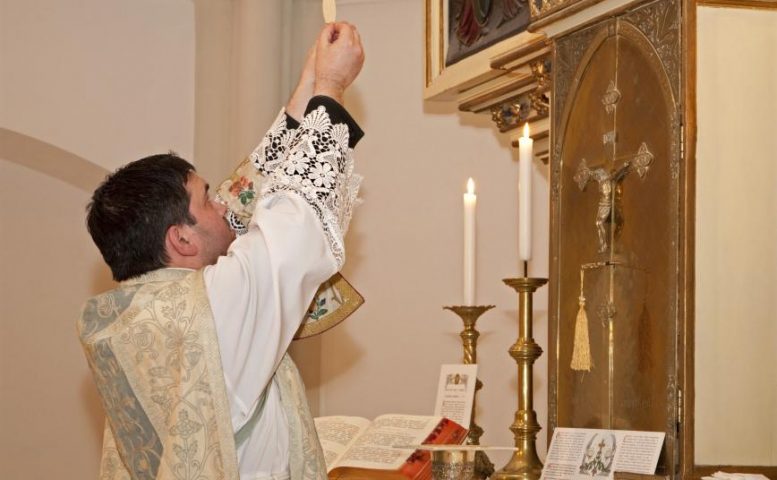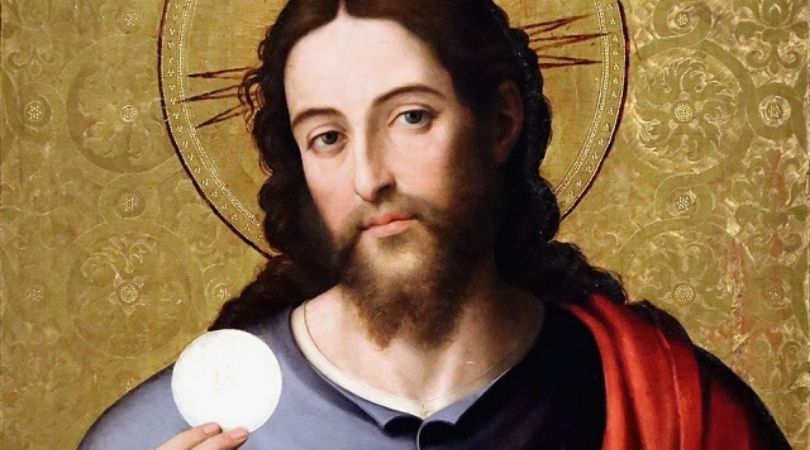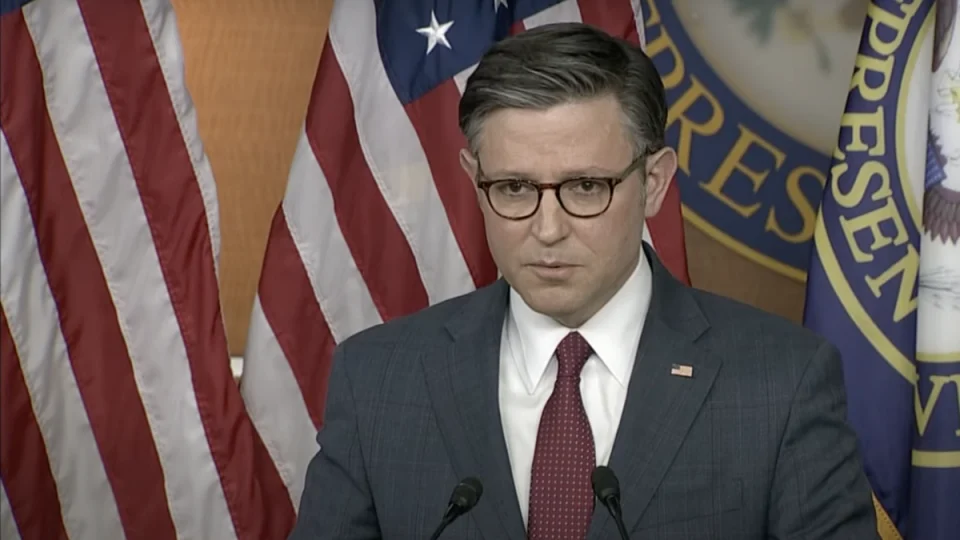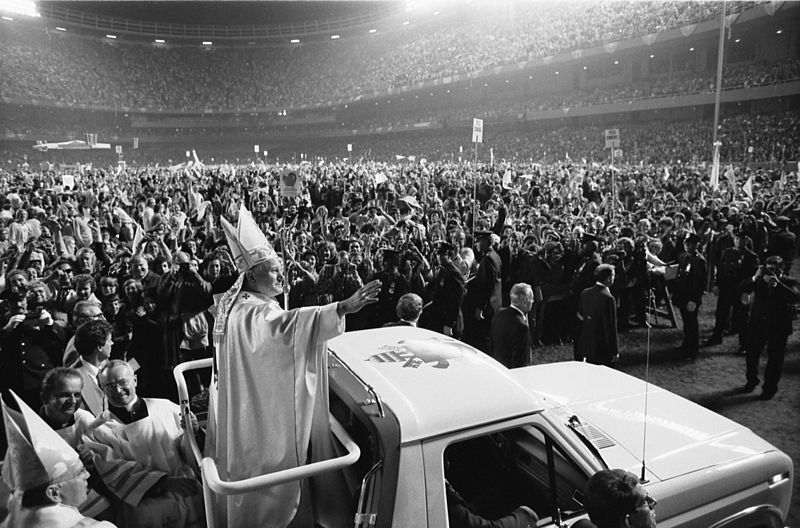The Apostasy of Our Times
February 12, 2018Benedict XVI’s Abdication, Five Years Later
February 12, 2018
By Stacy Trasancos, Catholic Answers, February 07, 2018
 During the Eucharistic Prayer, the celebrant raises the bread above the altar. He looks upward. He bows slightly. He says, “Take this, all of you, and eat of it, for this is my body, which will be given up for you.” The altar bells ring. And it just happens right in front of us: the Change.
During the Eucharistic Prayer, the celebrant raises the bread above the altar. He looks upward. He bows slightly. He says, “Take this, all of you, and eat of it, for this is my body, which will be given up for you.” The altar bells ring. And it just happens right in front of us: the Change.
Transubstantiation was codified in the sixteenth century. The Council of Trent (1546-1543) declared, just as Christ himself first announced at the institution of the Eucharist, that it is truly his body offered “under the species” of bread and wine and that
by the consecration of the bread and of the wine, a conversion is made of the whole substance of the bread into the substance of the body of Christ our Lord, and of the whole substance of the wine into the substance of his blood; which conversion is, by the holy Catholic Church, suitably and properly called transubstantiation (Chapter IV; CCC 1376).
The term was not new to the council, however. Four hundred years earlier, Pope Alexander III, who convoked the Third Lateran Council (1179), used the term before becoming pope. Pope Innocent III (1198) used it in his decretals. In 1215, the Fourth Lateran Council repeated the word in the Creed of Canon 1. Invoking Aristotelian natural philosophy, in the thirteenth century St. Thomas Aquinas developed the concept in the Summa Theologiæ (III.75).
The word is almost a millennium old, but the concept can still be explained using the modern language of chemistry.
The reactants and products
Scholastics identified a terminus a quo and a terminus ad quem: that which ceases to be and that which begins to be. For creation out of nothing, there is a negative terminus a quo; that is, nothing is changed into something (III.75.3). For annihilation, there is a negative terminus ad quem—something is changed into nothing. But transubstantiation is not like either of these kinds of changes.
Modern chemistry has no analog for negative being either since humans neither create matter out of nothing nor destroy matter. In chemical reactions, matter is conserved. The number of grams of reactants (the terminus a quo) equals the number of grams of products (terminus ad quem).
The eucharistic miracle begins with the pre-existing matter of bread and wine. These become the body and blood. Both have positive being. For transubstantiation, the whole substance of the bread and wine becomes the body and blood of Christ (III.75.4). Matter is conserved, just as in chemical reactions.
The conversion is different
In nature, there are two kinds of conversions: accidental and substantial. In an accidental conversion, the substance assumes a new appearance: such as when paper is folded, copper is drawn into wires, or ice melts. A chemist calls such a change of appearance a physical change. Paper, copper, water exist before the conversion. Paper, copper, water after.
In a substantial conversion, one form becomes another form. The matter is still there—such as when paper burns by combustion, copper rusts by exposure to oxygen, or hydrogen and oxygen gas become water—but the matter becomes new substances. This is called a chemical change. The bonds between atoms break and new bonds form to make different compounds with different compositions.
The new substances have unique properties. Ashes look nothing like paper, rust nothing like copper, water nothing like explosive gases. Even if the reactants and products appear the same, as they sometimes do, an elemental analysis would show that the composition is in fact different. The atoms must regroup, or it is not a chemical reaction.
In nature, however, every substantial conversion (rearrangement of bonds) also causes an accidental conversion (change in physical and chemical properties). This is not so in transubstantiation, which is why the new word was adopted. Transubstantiation is a conversion to a new substance, but it is unlike any natural conversion.
No chemical reaction
In Aristotelian terms, as many a catechist knows, we say there is a substantial conversion but no accidental conversion. The form changes. The terminus formalis a quo, the whole substance of the bread and wine, becomes the terminus formalis ad quem, the Body and Blood of Christ (see Ott, Fundamentals of Catholic Dogma, p. 380).
After transubstantiation occurs, the atoms and molecules continue doing their thing, just as they are, completely unaffected, as if nothing miraculous had happened at all. There is no chemical reaction and no accompanying physical change. The consecration breaks no chemical bonds and synthesizes no new ones.
But the substance is converted anyway! And that is the uniqueness. “The mode of Christ’s presence under the eucharistic species is unique” (CCC 1374). The whole substance—but only the substance—is converted.
The bread and wine do not disappear in steps or by motion (III.75.3). There are no intermediate states, no successive changes like batter baking or grapes fermenting. They change in full form by pure being. This is a mystery.
In an instant
Also mysterious is that transubstantiation occurs instantly. In science, even an infinitesimally small instant is taken to be an interval in time. For example, you may glance at your speedometer in your car to gauge your speed at that instant, but time passes in the shift of your eye. An instant is defined as a time interval that approaches zero.
Transubstantiation occurs in a timeless instant that St. Thomas expresses as both in becoming and in being simultaneously. This change, he says, is caused by a power that is infinite to which it belongs to operate in an instant. When the Eucharist unites us with the heavenly liturgy, we literally glimpse eternity, not with our eyes, but with our intellects and will.
A miracle of Being
To put that all together: yes, Catholics stare at bread and wine while absolutely nothing extraordinary physically happens, and then we recognize it as the real presence of the body and blood of Christ, the miracle that is the source and summit of the entire Christian life (Lumen Gentium 11), above all other sacraments.
It is almost absurd. Except that it is simply radical.
Transubstantiation is the most logical formulation possible to articulate Christ’s instructions at the Last Supper. Why? Because faith is the substance of things unseen (Heb. 1:1). What could be more unseen than a substantial conversion that cannot be observed with the most precise of elemental analysis? The eucharistic miracle belongs to the perfection of faith (III.75.1), supernatural, effected by God’s power alone, because only God can instantly dispose matter for the form.
The miracle is in the is. “This is my body,” a miracle of Being. Transubstantiation happens because Christ, the Word who was in the beginning, said so. It is the simplest and deepest reality, the reason that molecules, atoms, wheat, and grapevines, or anything, or any of us, exists at all. Everything is what it is because God speaks it into existence and holds it there. At every Mass, we witness both the physical laws of creation in the bread and wine and the sacrifice of the New Law instituted by Christ.



 During the Eucharistic Prayer, the celebrant raises the bread above the altar. He looks upward. He bows slightly. He says, “Take this, all of you, and eat of it, for this is my body, which will be given up for you.” The altar bells ring. And it just happens right in front of us: the Change.
During the Eucharistic Prayer, the celebrant raises the bread above the altar. He looks upward. He bows slightly. He says, “Take this, all of you, and eat of it, for this is my body, which will be given up for you.” The altar bells ring. And it just happens right in front of us: the Change.



